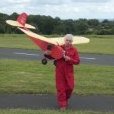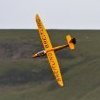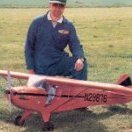Leaderboard
Popular Content
Showing content with the highest reputation on 07/05/22 in all areas
-
Last night I made the final vacform pulls of the canopies for the Dornier DO17 which my pal Jim is building. The 3D printed plugs were just a shade too big to print in one go, so needed to be done in two halves. Then they are just a touch too wide for my home made A4 vac-former -they fit, but there isn't room enough to get the soft floppy PETG down to the baseplate and get the vacuum pulling it all tight. That necessitated making an A3 vac-former, but the pull is nowhere near as strong on such a large box. That worked much better. The front canopy isn't quite perfect, as it has a bit of a crease on one pane, but it's close enough for jazz and Jim should be able to blend it in. The nose glazing pulled a perfect canopy first go, which was nice. On offering up the mouldings to the fuselage at the field this morning I was delighted -and a little surprised - to see that they fitted. Most importantly the PLA plugs have stood up to several pulls, without melting, which is excellent news. For slightly narrower canopies I'd expect perfect results from A4 PETG sheets. That was my main worry, as I had visions of the plugs melting into a congealed mass the instant the hot and floppy PETG hit them and the vacuum started to suck. My back-up was to make a papier mache carapace on the plug, fill that with Plaster of Paris and use that instead, as I know that works well. It was a pleasant surprise to find the PLA is tough enough to survive the contact with hot PETG and further heating to aid the shrink. Also printed the three visible crew members- the fourth member is buried deep in the fuselage - and five machine guns -all to 1/12th scale to fit the cockpit. The first pull, pictured above went really manky on the side, but the final one was only slightly manky. I reckon that for slightly narrower canopies, I wouldn't have that issue, which I believe is caused by there just being just not quite enough space between the plu and the hinged frame on the smaller vac-former. Thanks to Ron Gray for his advice when I was struggling to get the first plug to print at all, I'd have been stuck without his words of wisdom.2 points
-
I have been a very big fan of OpenTX since I bought my first Taranis around 2013 or 2014. The only thing that I disliked about it was its poor hardware quality. The long switches at the back broke off just by looking at them, and the plastic switches around the screen were just as awful as it gets. In terms of capabilities and features, OpenTX wins hands down. Not to mention the Companion program, which allowed me to bypass the very awkward way of navigating through the menus on the Taranis, and not having to use the no-feedback plastic select switches around the screen. After damaging the antenna (my stupid mistake), I got errors about the antenna on the screen, so I replaced it by a Horus X10S, which is brilliant in so many ways, except its weight and the battery life. I replaced the battery with a 2P2S Lipo, getting me 7000mAh and many days at the field before a recharge (that also takes as many days, lol). When Ethos came out on the X20, I was intrigued, but I share the feeling about a closed and proprietary system. Recently, a fellow club member sold his X20S for a price that I couldn't refuse, so I decided to try it out. First of all, I'm not a fan of touchscreen. The buttons are way too small to be practical, even with my tiny little fingers. And having to really avoid touching the screen when manipulating the radio around the field is another worry that I have. I want at least to be able to disable the touch function when I'm not programming the radio. Ethos has caught up considerably with OpenTX, but I'm still missing things like real calculated telemetry fields, using simple arithmetic. I'm used to measure current, then calculate power by multiplying it with battery voltage. Not possible on Ethos at this point. A lot of things are clearly derived from OpenTX, but implemented differently and located at other places in the menus. Take for instance the "delay up" and "delay down" on a channel. In OTX, it is in the channel setup screen, next to the "slow up" and "slow down". In Ethos, you have to use a sequencer mix (I think). All settings that you can find together in the channel setup in OTX are spread over "Mixes" and "Outputs" in Ethos. It takes some getting used to. OpenTX development seems to have come to a halt somehow, and morphed into EdgeTX. I don't know what to think of EdgeTX, but it feels to me like it is being branched all over the place to implement all sorts of features and multi-protocol stuff, which scares me as a software architect. I really like the hardware, the form factor and the weight of the X20S, even as a "pincher" (I added a tray and long sticks with integrated switches). I even prefer those aspects of it over my X10S. Except the screen, which is much brighter on the X10S. The screen on the X20S is a bit harder to read in sunlight, probably due to the touch screen layer. I have kept an open mind over Ethos, I'm starting to get used of it but still find some things awkward. Maybe it's my programmers brain that prefers OTX being more logical and organized than the "fancy layer" that Ethos is and confuses me all the time? I feel like being forced into some straightjacket of pre-programmed mixes that I don't need and don't use. Which is the very reason why I never liked radios like Spektrum; I could never figure those out. You have to find in whatever they supply as mixes and try to achieve simple stuff by endlessly combining and manipulating preprogrammed stuff. In OTX, I just select a certain channel, then add and mix whatever inputs that I want to combine. Where is the steep learning curve in that? But I keep an open mind over Ethos, and try to program my existing models in it, one by one, to learn and test. And I must admit, it's good, it works well so far. I use both radios at the field, and don't have any problems going from one to the other when changing models.2 points
-
I don't think the KWh added were shown Gary. There was lots of in depth information available if you dig into the menus but after an initial curiosity I seldom interrogated them. In common with most PHEVs the Prius has several selectable driving modes including pure EV, hybrid & charge the battery. So whilst the IC will always kick in if/when you deplete the battery you can also select it to operate if you want to retain the charge for use later in the journey. I no longer have the car as I swapped it at the end of the PCP for a Kia Soul EV. The 3 years I had it & the minimal amount of times I added petrol persuaded me that a pure EV fitted my lifestyle in retirement. Over 10 years I went from a V8>standard hybrid>plug-in hybrid>EV and for everyday transport I can't see me going back to IC. That said I also have a totally impracticable MX-5 for sunny days!2 points
-
The story continues. I did fly it again on the 23 March, well sort of! ☹️ https://www.youtube.com/watch?v=fScE_1Ygcbs I really should have known better but I suspect it was a case of "I am here so I will fly". Clearly the RH motor was not performing as it should with the inevitable results. I probably could have managed if the motor had failed in flight but on a hand launch - no way! The damage was not that severe, just a crushed nose but with everything permanently 'built in' finding out what was wrong withhte RH nacelle and putting it right would likely be a major job. After hanging on the wall for nearly a month I felt I had to make a start. Having plenty of construction pictures is a great help in determining exactly where everything is under the skin and where to cut! So first cut back the nose to a 'sound' former and make good any locally damged skin. Infact even the sound former was replaced with an identical one but twice as wide, 4 mm rather than 2mm) to give a surface to stick the new skin planks on to. Thank goodness I had kept all the FreeCad files. ? At this point I knew I could rebuild the nose so I turned to the problem with the RH motor and/or its ESC. Cutting open the wing underside exposed the Little Bee 20A opto ESCs. To my delight I had connected them using 2mm bullet connectors making it possible to test the motor iindependently with another ESC than was known to work. It confirmed the motor was the problem. To extract and replace the motor was going to involve destroying the motor mount and the nacelle pylon. As can be seen in the picture at least the inlet duct of the nacelle couldbe saved for reuse. Having extracted the motor a close inspection revealed the problem. Claerly one winding was seriously 'cooked'. ? Then I discovered that this LDPOWER 2204 2300kV motor is a 'discontinued item' as fas a Hobby King are concerned, but then I did by the original CW & CCW pair in 2010! Fortunately i did have a spare vitually identical CW Emax 2205 2300Kv motor that fortunately uses the same pich mounting holes and is actually 2g lighter. The whole nacelle pylon, motor mounting and exhaust duct is a one piece part so 3D printing 'saved' me again! To be continued.2 points
-
This is good news indeed. I quite fancy a Radio Queen. I used to have one which I used to give elderly beginners their first experience of R/C flight. I wish I'd never sold it now. https://www.facebook.com/groups/250728948636570/?hoisted_section_header_type=recently_seen&multi_permalinks=16295392340888611 point
-
On the 6th & 7th June, (the Queens platinum jubilee weekend), an informal vintage glider meet is taking place at the Bwlch, (between Nant-y-Moel & Treorchi) in S Wales. So many of us are busy prepping our old model gliders ready for this event. I'll be taking a Dynaflite Bird of Time and a model I have recently acquired especially for this event, the Robbe Verso. I picked this up from a guy in Warwickshire who hadn't flown it since the 1980's. There is a video below showing me flying it for the 1st time below. So if you are a glider guider with nothing better to do over that bank holiday weekend, come along to the Bwlch and join in the flying and banter with the others.1 point
-
I wanted to go but i needed a boat to get to my car and i would have been drenched by the time i got the car loaded as it was really coming down. I waited as long as i could for it to clear but hit a point where i no longer had time to drive up there and arrive at a sensible time. A few years back i flew at wings and wheels in the rain and i am super not interested in repeating that experience. With the grass likely sodden and all the rest of it i decided to give it a miss. Also today was the day my Dad was doing the tiger moth flight experience my brothers and i got him for his birthday. as i had double booked myself by accident anyway, and the weather on the south coast for his flight looked better i decided to go for that instead and we had a good day. Shame to hear about the mustang but the grass must have been mega long for it to nose over like that. Perhaps next time someone should bring a mower for last minute grass adjustment1 point
-
Sorry folks, me again. I succumbed to temptation and bought another glider from the same estate sale I picked up the Centiphase. Couldn't resist it; tissue covered as you can see, 113" span, 2-channel, and with a distinctively undercambered wing. Very light. A lovely sculptured nose too. All-moving fin. But can anyone pout a name to it?1 point
-
Thanks Pat, that looks pretty darn spot on to me. ??1 point
-
It could be a John Hancock designed Halcyon - RM 118. What span is it ? The Halcyon was 110" very lightweight, IIRC about 5 or 6oz/sq ft - too light actually for most competitions back in the day.1 point
-
I thought it was a good day out but I was disappointed to miss out on Ron's Mustang. I was one of those chatting to you soon afterwards, along with Chris Walby - good to meet you both.1 point
-
Now just the long wait to see whether what should be stuck is loose, and what should move is actually stuck...1 point
-
I think it is a matter of finding edf plans and seeing if your unit can be made to fit. With the power available from modern edf units it might be worth looking at some of the old ic ducted fan plans. Particularly bearing in mind how inefficient ic ducted fan drives were.1 point
-
So I’m not clear what the problem is! If it is just that the visible down elevator trim offends your eye, then adjust the tailplane incidence accordingly. Personally though, as long as you have enough physical down elevator travel for inverted flight and negative g manoeuvres, I really wouldn’t bother.1 point
-
It has been flown a lot before me, on just the two hinges. But it does not seem to be a lot to hold a big surface so I'll put another one in. There is a pretty substantial bar on both sides of the hinge line, so there are no special places for the hinges. I thought I had lost the servo screws, but they turned up.1 point
-
I think it only fair we should acknowledge the subsidies handed out to ICE drivers: Autumn Budget Fuel duty has been frozen since 2011 and now reduced: Fuel duty rates 2022-2023 As the saying goes “the only two certainties in life are death and taxes” ? idd1 point
-
Thank you for subsidising my use of the road Martin! Actually you are only subsidising about a third, as two thirds of the revenue raised goes into general taxation (£35B revenues vs £11B spent on the roads). Clearly the exchequer will have to make up the shortfall in revenue as more and more people go over to the ‘dark side’ (EVs) and there is certainly a lot of talk about it. However at the moment it is just talk and speculation - nothing is decided. A road pricing strategy using GPS and taking into account not only vehicle weight but also geographical area (rural/urban/inner city) will eventually evolve. However the technology/infrastructure/software will have to be developed and installed in all vehicles. More significantly, acre’s of legislation will be required concerning confidentiality and data protection. How long will all this take, considering the consultation documents, inquiries and parliamentary debate involved? Meanwhile, I am saving £2000+ pa in fuel and road tax ?1 point
-
Save the planet, keep the old ones going. The carbon foot print from producing this one went up 32 years ago. Still my main work truck-local run around and even takes models to the strip.1 point
-
Tim, governments (of all nationalities & political persuasion) never lack imagination when they think of criteria on which to levy tax.1 point
-
The replacement motor mount, pylon and exhaust duct withthe Emax 2205 installed. The exhaust interior and the tail cone are painted a plausible dark sea grey. The tail cone apart from giving a scale appearance also retricts the exhaust to 95% of the FSA which increases the static thrust be some 5%. Every little helps. The complete RH nacelle installed in the wing and painted. The nose completed with the new black Fablon windscreen outline. It always was a bit of a crude solution but it is light! Hopefully I will be able to actually test it this evening with a video1 point
-
Hi, Although you can move the motor my hand when it spins throughout the rev range it stays very axial. I suppose you can think of it as like one of those flexible mounts - if you push spinner the motor will move slightly but when it spins up it stays aligned, it doesn't move around. With this type of foamy there are no hinges as such the tail plane and elevator are a single moulding with a thin toughened interface between the two so it is 'hinged' along the whole length. The control rods and horn are fine, as are the servos.1 point
-
I agree that it's all too easy to get hung up on telemetry. Some is very useful, such as consumed mAh, if you fly electric. With the advent of the ACCESS protocol FrSky have made available the VFR (Valid Frame Rate) metric. I believe it equates roughly to a measure of link quality. It's why I am considering configuring a warning if both RSSI and VFR drop below a certain level - it might be a better way of identifying a real low signal scenario. That said, I can't remember ever having signal problems in about 16 years of RC flying!1 point
-
Well, this is really moving slowly. However I bit the bullet today and it has gone pretty well. Cut the good hinge on broken side, and with some wiggling I was able to get that elevator half off the elevator joiner wire. That was a big relief as otherwise I had to take the other side off as well, and the rudder, and the closed loop wires... The Robart pins came out pretty easily. One pushed in (by mistake), two pulled out, one I had to drill out. It turns out that the hinges have been done before, one was off-centre because of a remaining stub. I am trying to get that stub out.1 point
-
1 point
-
I always do a range check with the model about 1 meter above the ground, in "all" directions (I rotate the model on a stand and do the range check again) to detect any reception blind spots. Vegetation like grass (anything containing water basically) blocks out a 2.4 GHz signal in a very effective way, so make sure there isn't anything like that between transmitter and receiver.1 point
-
Why pay a ‘£73,000 purchase price’ Steve? A Leaf will set you back £28,000 at todays prices, or £1000 down and £270 month for 4 years (then give it back on a PCP deal). You can then go back to an ICE car if you want but I am confident you won’t, if your motoring requirements are anything like mine.1 point
-
1 point
-
I'm certainly not "preaching". I couldn't care less what anyone else does. You carry on filling up with diesel for 70, 80 or whatever Euros a tank and I'll carry on filling up my car for about £4!1 point
-
By the time you're finished Paul, it will be running better than it was new from the factory. What do you call it now - a ROSsEnya 120?1 point
-
1 point
-
Have a look at the jetworks website ,they have downloadable plans for edf jets .The plans are for smaller edf units but they can be printed at different sizes to suit your fan . There are files for 3D printed parts as well1 point
-
Electric charging plugs in houses over here has been mandatory for 2 years, as for the numbers ie , + 35% or whatever they are meaningless, lets have month by month numbers for a few years, as for 'hybrids' it's a gimmick, 35 miles on a charge and then 400 miles dragging an electric motor electronics and a 300 kilo battery around,,,1 point
-
The Sinclair C5 was a disaster (like a lot of Clive Sinclair's products). At the time, I was regularly riding (and occasionally racing) a racing trike and was always hoping to see one so I could overtake it pedalling ? Someone did, very briefly, ride one to work and I just once saw one on the road when we were in the car. The C5 probably did more to put people off electric vehicles than the reverse.1 point
-
well in some senses yes, as they have more power and range but I cannot see that making batteries two or three times their actual needed size plays toward reducing damage to the planet, or having way more power than needed is helping much of anything the problems the fleshy bit behind the wheel1 point
-
All back together with a bit of remedial filling and some touching up of the paintwork. Apart from the satisfaction of getting it repaired there really was no rush as it won't be flying at the field again until the worst of the foot prints have be smoothed out and the grass has been cut at least a couple of times, likely June, so its back into storage.?1 point

















